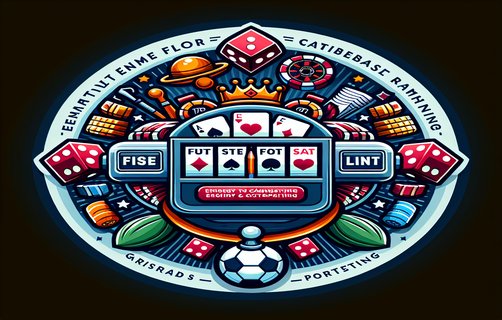Mastering the Art of Game Mechanics: Deckbuilding and Beyond
खेल के तंत्र की कला में महारत: डेकबिल्डिंग और इससे आगे
In the ever-evolving world of tabletop games, the intricate interplay of mechanics makes each game a vibrant experience. One of the most compelling aspects is deckbuilding, where players meticulously curate their cards to create strategies, coalescing their visions into a cohesive gameplay experience.
Deckbuilding is not just about acquiring cards; it involves understanding the synergies between them. Players delve deep into the strengths and weaknesses of each card while seeking to optimize their decks. The ultimate goal? To forge the most formidable arsenal of choices for gameplay, enhancing both competitiveness and enjoyment.
However, even the best strategies can be thwarted by the nuances of rule exceptions handling. Every game has its unique set of rules, and exceptions can become battlegrounds of interpretation. A well-defined framework can minimize disputes, fostering an atmosphere of fair play and excitement. Clear communication on these exceptions ensures that all players are on the same page, allowing gameplay to flow seamlessly.
Equally important is turn length balancing, a crucial factor that maintains the rhythm of the game. If one player takes too long, it disrupts the experience for others and can lead to frustration. By defining reasonable time constraints, designers can promote engaging and dynamic turn-taking that keeps everyone invested in the action.
Game trays are the silent heroes of tabletop organization. They streamline the setup process, allowing players to focus on strategy rather than sorting through a mountain of components. A well-designed game tray does not only enhance accessibility but fosters a more immersive experience, where players can quickly grasp what is at their disposal and pivot their strategies accordingly.
Balancing random factors plays a pivotal role too. While randomness can introduce excitement and uncertainty, it must be carefully managed to maintain a competitive backdrop. Designers employ mechanics that level the playing field, ensuring that fortune favors not just the lucky but also the skilled players. This delicate dance between chance and choice defines the essence of a well-crafted game.
Finally, points scoring areas encapsulate the crux of competition. It is here where strategies coalesce, victories are etched, and stories form. Points scoring should reward innovative play and encourage players to experiment with their strategies. By focusing on dynamic scoring systems, designers can turn typical point accumulation into an engaging pursuit that keeps players on their toes.
In conclusion, the art of game mechanics—from deckbuilding to handling rule exceptions, balancing turn lengths, and managing random factors—is a tapestry woven with creativity and strategy. Game designers strive to create an experience that is not only enjoyable but also enduring, inviting players to return time and time again. As the tabletop landscape continues to evolve, these core mechanics will remain essential to crafting unforgettable experiences.
टेबलटॉप खेलों की लगातार विकसित हो रही दुनिया में, तंत्र का जटिल अंतर्संबंध प्रत्येक खेल को जीवंत अनुभव बनाता है। सबसे आकर्षक पहलुओं में से एक डेकबिल्डिंग है, जहाँ खिलाड़ी अपने कार्डों को ध्यान से संकलित करते हैं ताकि रणनीतियों का निर्माण किया जा सके, अपने दृष्टिकोण को एक समग्र गेमप्ले अनुभव में संकलित कर सकें।

डेकबिल्डिंग सिर्फ कार्ड हासिल करने के बारे में नहीं है; यह उनके बीच के संबंधों को समझने के बारे में है। खिलाड़ी प्रत्येक कार्ड की ताकत और कमजोरियों के बारे में गहराई से कदम रखते हैं जबकि अपने डेक को अनुकूलित करने का प्रयास करते हैं। अंतिम लक्ष्य? गेमप्ले के लिए सबसे शक्तिशाली विकल्पों का एक आर्टिलरी बनाना, जो प्रतिस्पर्धा और आनंद दोनों को बढ़ाता है।
हालांकि, सबसे बेहतरीन रणनीतियों को नियम अपवाद के प्रबंधन की बारीकियों द्वारा विफल किया जा सकता है। प्रत्येक खेल का अपनी विशिष्ट नियमों का सेट होता है, और अपवाद व्याख्या के युद्धक्षेत्र बन सकते हैं। एक अच्छी तरह से परिभाषित ढांचा विवादों को कम कर सकता है, निष्पक्ष खेल और उत्साह के वातावरण को बढ़ावा देता है। इन अपवादों पर स्पष्ट संवाद यह सुनिश्चित करता है कि सभी खिलाड़ी एक ही पृष्ठ पर हों, जिससे गेमप्ले बिना रुकावट के चल सके।
टर्न लंबाई संतुलन भी महत्वपूर्ण है, यह एक ऐसा कारक है जो खेल की लय बनाए रखता है। यदि एक खिलाड़ी слишком अधिक समय लेता है, तो यह दूसरों के अनुभव को बाधित करता है और निराशा का कारण बन सकता है। उचित समय सीमा को परिभाषित करके, डिजाइनर गतिशील और दिलचस्प टर्न-टेकिंग को बढ़ावा दे सकते हैं जो सभी को क्रिया में निवेशित रखता है।

गेम ट्रे टेबलटॉप संगठन के मौन नायक हैं। वे सेटअप प्रक्रिया को सरल बनाते हैं, खिलाड़ियों को रणनीति पर ध्यान केंद्रित करने की अनुमति देते हैं न कि घटकों के एक पहाड़ के माध्यम से छंटाई करने में। एक अच्छी तरह से डिज़ाइन की गई गेम ट्रे न केवल पहुंच को बढ़ाती है बल्कि एक अधिक immersive अनुभव को प्रोत्साहित करती है, जहाँ खिलाड़ी जल्दी से समझ सकते हैं कि उनके पास क्या है और तदनुसार अपनी रणनीतियों को मोड़ सकते हैं।
यादृच्छिक कारकों की संतुलन भी एक महत्वपूर्ण भूमिका निभाती है। जबकि यादृच्छिकता रोमांच और अनिश्चितता ला सकती है, इसे एक प्रतियोगी पृष्ठभूमि बनाए रखने के लिए सावधानी से प्रबंधित करना चाहिए। डिजाइनर ऐसी तंत्रों का उपयोग करते हैं जो मैदान को स्तरित करते हैं, यह सुनिश्चित करते हैं कि किस्मत केवल भाग्यशाली पर नहीं, बल्कि कुशल खिलाड़ियों पर भी मेहरबान हो। यह अवसर और पसंद के बीच का नाजुक संतुलन एक अच्छी तरह से तैयार किए गए खेल के सिद्धांत को परिभाषित करता है।
अंत में, अंक स्कोरिंग क्षेत्र प्रतिस्पर्धा का सार रखते हैं। यहीं पर रणनीतियाँ एकीकृत होती हैं, विजय अंकित होती हैं, और कहानियाँ बनती हैं। अंक स्कोरिंग को नवोन्मेषी खेल को पुरस्कृत करना चाहिए और खिलाड़ियों को उनकी रणनीतियों के साथ प्रयोग करने के लिए प्रोत्साहित करना चाहिए। गतिशील स्कोरिंग सिस्टम पर ध्यान केंद्रित करके, डिजाइनर विशिष्ट अंक संचय को एक रोचक प्रयास में बदल सकते हैं जो खिलाड़ियों को सतर्क रखता है।
अंत में, खेल तंत्र की कला - डेकबिल्डिंग से लेकर नियम अपवाद के प्रबंधन, टर्न लंबाई को संतुलित करने और यादृच्छिक कारकों का प्रबंधन करने तक - एक रचना है जो रचनात्मकता और रणनीति के साथ बुनी जाती है। गेम डिजाइनर एक ऐसा अनुभव बनाने के लिए प्रयासरत है जो न केवल मनोरंजक हो, बल्कि शाश्वत भी हो, खिलाड़ियों को बार-बार लौटने के लिए आमंत्रित करता है। जैसे-जैसे टेबलटॉप वातावरण विकसित होता है, ये कोर तंत्र अद्वितीय अनुभवों को तैयार करने के लिए आवश्यक बने रहेंगे।

comments
GameNinja42
This article beautifully highlights the intricate details of game design. It's so inspiring!
DeckMaster007
I really appreciated the section on turn length balancing. It’s often overlooked but so crucial.
CardCrafter88
The insights on deckbuilding are spot on! Can't wait to apply these tips to my next game night.
TabletopTactician
Great read! The emphasis on rule exceptions handling is something every player should understand.
PlayTestPal
The article has sparked so many ideas for our next game design session!